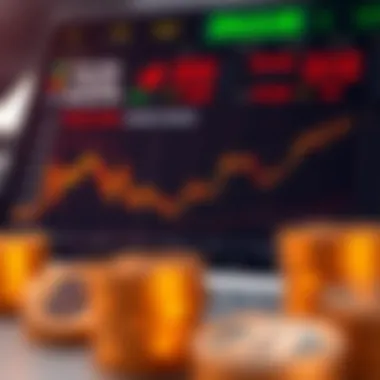Exploring Coinbase Margin Accounts: Benefits and Risks


Intro
In the rapidly evolving landscape of cryptocurrencies, understanding the intricacies of trading mechanisms is essential for maximizing potential gains. Margin accounts, particularly those provided by Coinbase, offer a unique opportunity to trade using borrowed funds. However, this dual-edged sword, while enticing for potential profits, also introduces significant risks that every investor must navigate with caution.
As crypto markets oscillate in response to news, trends, and investor sentiment, margin accounts can amplify both profits and losses. Thus, a thorough examination of how these accounts work, the advantages they present to savvy traders, and the potential pitfalls they encompass is paramount.
This guide aims to equip you with a comprehensive understanding of Coinbase's margin accounts while providing insightful strategies for approaching margin trading thoughtfully.
Crypto Trends and News
Latest Market Updates
With the blockchain ecosystem continuously in flux, staying abreast of market updates is essential. Recently, cryptocurrencies have witnessed fluctuating prices, influenced by global economic events, regulatory changes, and investor dynamics. For example, Bitcoin's price volatility spiked in response to institutional adoption news, while Ethereum's shift towards a proof-of-stake model garnered substantial attention. Such developments not only sway individual cryptocurrency values but also impact the broader trading strategies used in margin accounts.
Upcoming ICOs and Projects
The landscape is rich with new investment opportunities, particularly through Initial Coin Offerings (ICOs). Understanding which ICOs are on the horizon can be valuable for those utilizing margin accounts. Anticipating these trends allows investors to position their portfolios strategically. Keep an eye on platforms like ICO Drops and CoinGecko for insights into upcoming projects that could influence market shifts.
Education and Resources
Beginner's Guide to Cryptocurrency
Before diving into the complexities of margin accounts, it's crucial to grasp the fundamentals of cryptocurrency. Newcomers should familiarize themselves with concepts like blockchain technology, wallets, and how exchanges operate. Websites like Investopedia provide a wealth of information tailored for beginners looking to establish their footing in the crypto world.
Advanced Investment Strategies
For those ready to take the plunge into margin trading, advancing your understanding of investment strategies becomes vital. Topics like technical analysis, risk management, and market psychology merit attention. As margin trading can lead to significant risk, seeking resources like TradingView for chart analysis and CoinMarketCap for market insights can sharpen your strategic edge.
As you navigate Coinbase's margin accounts, leveraging both foundational knowledge and advanced strategies will enable you to approach trading with confidence and a readiness to tackle risks head-on.
"In the world of trading, knowledge is your greatest asset."
In summary, by understanding market trends, anticipating new projects, and utilizing educational resources, investors can enhance their margin trading experience on platforms like Coinbase. Awareness combined with strategic insight creates the potential for success in the world of cryptocurrencies.
Preface to Margin Trading
Margin trading stands as a pivotal concept in the financial landscape. For those looking to amplify their trading endeavors in the volatile world of cryptocurrency, understanding margin trading is not just helpful; it's essential. This section aims to unpack the nuances of margin trading, laying the groundwork for a deeper conversation surrounding Coinbase's offering of margin accounts.
Engaging in margin trading means borrowing funds to invest more than what your current capital allows. It’s akin to taking a loan to purchase a bigger slice of the pie; the potential to reap higher rewards comes with the flipside of risk. For instance, an investor wishing to capitalize on a bullish trend can leverage margin to increase their position size, significantly enhancing their potential returns. However, this added muscle can just as easily translate into amplified losses if the market moves against them.
Key Points to Consider:
- Leverage: Central to margin trading is the leverage provided by brokers or exchanges like Coinbase. This allows traders to control a more substantial amount of assets with a smaller initial investment.
- Risk Management: Due diligence is paramount. Assessing your risk tolerance and having a solid strategy is essential to avoid sudden losses.
- Market Knowledge: Investors must possess a keen understanding of market trends, as the rapid nature of crypto trading can lead to swift and severe fluctuations in value.
"Margin trading amplifies not only your profits but also your losses; tread lightly and stay informed."
Coinbase Overview
Understanding the mechanics behind Coinbase and its margin accounts is paramount for anyone keen on navigating the often choppy waters of cryptocurrency trading. Coinbase has evolved into one of the foremost cryptocurrency exchanges globally, not only for buying and selling digital currencies but also for offering advanced trading features like margin accounts.
As digital assets proliferate, the demand for platforms that enable leveraged trading has risen steeply. Margin accounts on Coinbase allow users to borrow funds against their existing balances or investments, empowering them to maximize their potential profits. However, this also brings about a heightened level of risk, putting them in precarious situations if the market turns against them.
Coinbase as a Cryptocurrency Exchange


When one thinks of cryptocurrency exchange, Coinbase typically springs to mind. Launched in 2012, the platform allows users to purchase various cryptocurrencies using fiat currency. Its user-friendly interface, coupled with robust security measures, has attracted millions. But what sets Coinbase apart from the myriad of exchanges available?
- User Experience: Coinbase prioritizes ease of use, making it accessible even for newcomers who are just dipping their toes into the crypto world. This is particularly important for individuals who may find technical trading platforms daunting.
- Security: With multiple layers of security protocols in place, including two-factor authentication and insurance on digital assets, Coinbase reassures users about the safety of their investments.
- Regulatory Compliance: As a regulated exchange, Coinbase adheres to financial laws and practices that provide a level of trust not always found in its competitors.
Even though there are drawbacks—like higher fees compared to some platforms—Coinbase caters well to those looking for reliability and an expansive asset range.
The Development of Margin Accounts on Coinbase
The introduction of margin accounts on Coinbase was a strategic move to stay competitive and meet the needs of active traders. Since its initial development, margin trading has changed the game for many investors looking for additional leverage in their trading endeavors. Here’s a look at key aspects:
- Enhanced Trading Opportunities: Margin accounts allow traders to borrow against their collateral, which means they can take larger positions without requiring full cash upfront. This can significantly amplify potential gains, turning modest investments into substantial returns.
- Evolving Landscape: As market dynamics shift, ensuring that margin accounts evolve accordingly is essential. Coinbase has adapted to market conditions by refining its margin trading services, focusing on user experience and risk management.
- Targeted Towards Advanced Traders: While not designed for inexperienced investors, margin accounts attract a niche market of experienced users who are well aware of the risks they entail. This focus positions Coinbase as a forward-thinking exchange that understands its audience.
"Margin trading can be as risky as it is rewarding; understanding both sides of the coin is crucial."
The development of margin accounts on Coinbase enriches the trading toolbox available for users. To reap its benefits, traders must remain vigilant, balancing the prospects of profitability against the risks of leveraged positions.
Features of Coinbase Margin Accounts
Understanding the features of Coinbase margin accounts is essential for anyone looking to venture into margin trading. This section focuses on the fundamental elements that define these accounts, while putting a spotlight on their benefits and the critical considerations involved. Using borrowed funds to enhance trading capacity has its allure, but as all seasoned traders would remind you, knowledge is your strongest ally.
Interest Rates and Fees
When engaging in margin trading through Coinbase, the interest rates and associated fees are significant factors to contemplate. Coinbase typically charges interest on the borrowed funds, which can add up over time. The rates can vary based on the specific cryptocurrency being traded and other market factors. Thus, one needs to keep a vigilant eye on the interest rates set by Coinbase.
- Example: If a trader borrows $1,000 to purchase Bitcoin and the interest rate is set at 8% per annum, that trader would need to account for approximately $80 in interest payments if the position is held for a year.
Moreover, Coinbase may impose additional fees for executing trades or withdrawing funds, which could eat into profits. A comprehensive analysis of these costs before diving into margin trading could prevent unwelcome surprises later on.
"Beware of hidden costs; what seems appealing on the surface may not be so underneath."
Trading Limits and Conditions
Coinbase sets specific trading limits and conditions for margin accounts. These conditions can dictate how much capital one can borrow relative to the equity in their account, often referred to as the ‘margin ratio’. Understanding these limits is pivotal as they directly influence a trader's strategy.
- Higher Limits: Generally, experienced traders with larger accounts may qualify for higher borrowing limits.
- Lower Limits: On the other hand, new or lower-capital traders could face stricter limits, which result in a lower ability to leverage their positions.
Additionally, it's worth noting that Coinbase may adjust these limits based on market conditions and regulatory considerations. Staying attuned to any updates related to trading limits can be the difference between a well-executed trade and a missed opportunity.
Supported Cryptocurrencies for Margin Trading
One of the most robust aspects of Coinbase margin accounts is the range of supported cryptocurrencies. While Bitcoin and Ethereum are the most commonly traded, other digital assets also make the cut. Each supported cryptocurrency has its unique attributes that can influence market movements.
Some of the cryptocurrencies available on Coinbase for margin trading include:
- Bitcoin (BTC)
- Ethereum (ETH)
- Litecoin (LTC)
- Chainlink (LINK)
It’s crucial to understand that not all cryptocurrencies have the same level of liquidity or price stability. Therefore, a trader’s choice of which crypto to engage in margin trading with can carry significant implications for both potential gains and risks.
Being mindful of the available options and aligning them with your trading strategy may empower you to make well-informed decisions in the ever-fluctuating crypto landscape.
Setting Up a Coinbase Margin Account
Setting up a margin account with Coinbase is a crucial step for those looking to leverage their investments in the cryptocurrency realm. It opens doors to enhanced trading potential, but it also mandates a clear understanding of the implications, requirements, and the overall process involved. This segment will unpack the various layers of setting up a margin account, making it a critical read for investors eager to dip their toes into this complex yet potentially rewarding arena.
Eligibility Criteria


Before diving into the setup process, it's essential to grasp the eligibility criteria needed for opening a Coinbase margin account. Firstly, users must have an established Coinbase account. This basic requirement ensures that you’ve engaged with the platform and its features previously. Next, you typically need to be situated in a jurisdiction where margin trading is permitted — regulations can differ significantly between regions.
Another important point is that users typically need to provide a certain minimum balance to qualify for margin accounts. This ensures that you have a financial buffer before engaging in higher-risk trading. Furthermore, being over the age of 18 is a non-negotiable, as this coincides with many financial regulations. If you fit the mold here, you're one step closer to accessing the world of margin trading.
Account Verification Process
The account verification process with Coinbase serves as a safeguard to ensure security and compliance. This multi-step verification generally begins with confirming your identity. This might involve submitting IDs like a passport or a driver’s license, accompanied by a selfie for a quick verification.
Moreover, you’ll also need to link a bank account or a credit card. Linking a bank account seems to be favored since it’s typically more straightforward for transferring funds. This whole process can feel a bit meticulous, but it underpins the integrity and security of the trading environment. Once you've cleared these hurdles, you’re on your way to activating your margin account. Don’t forget, on occasions, Coinbase might ask for additional documentation, which is part of their commitment to regulatory compliance.
Funding Your Margin Account
Funding your margin account correctly is the final piece of the puzzle. New traders can find the funding aspect a bit daunting, but understanding it will make the journey smoother. Primarily, you’ll start by transferring funds from your bank account to your Coinbase platform. Once the funds are cleared, you can allocate a portion to your margin account specifically.
It's important to know that you don’t have to fund the entire amount in one go; depending on your trading strategy, you might opt for incremental funding as you engage in trades. Furthermore, be mindful of the multi-currency aspect. If you’re planning to trade cryptocurrencies other than Bitcoin, you’ll want to ensure you're adequately funded in the respective assets. This can oftentimes mean a little juggling of funds, but it allows you the flexibility to seize opportune moments in the market.
"With great power comes great responsibility. Margin trading amplifies your potential, but it also magnifies your risk."
For further insights, consider exploring links from trusted sources such as Wikipedia and relevant discussions on Reddit.
Navigating Risks of Margin Trading
Margin trading, while tantalizing for its potential rewards, is a double-edged sword that can lead to significant pitfalls if not approached with caution. For anyone considering engaging with margin accounts—particularly on platforms like Coinbase—it is crucial to grasp the intricacies of the risks involved. In this section, we’ll explore several critical aspects of these risks, spotlighting how they can affect your trading journey and imbuing you with a deeper understanding that could prove beneficial in your investment endeavors.
Potential for Amplified Losses
When entering into the realm of margin trading, one of the most notable characteristics is the potential for amplified losses. Simply put, using borrowed funds to trade means that your losses can also multiply alongside your gains, leading to a precarious situation for investors.
Imagine placing a bet on a high-stakes poker game, only to realize midway that your cards are not as strong as you initially believed. In the financial world, this translates to a scenario where, if the market turns against you, you may not only lose your own invested capital but also owe the broker or exchange the borrowed funds. This situation is often encapsulated in the old adage: "What goes up must come down."
- Key Points to Consider:
- If the asset price drops, you may be forced to sell at a loss.
- The percentage of loss can be much greater than if you were trading without leverage.
- Trading responsibly and knowing when to cut losses is essential in this environment.
Market Volatility and Its Implications
The cryptocurrency market is notoriously volatile. Rapid price fluctuations can create a rollercoaster of emotions for traders. When trading on margin, this volatility can be a double whammy, as small market movements can lead to drastic changes in your equity position. Being aware of the inherent instability of the market is tantamount to safeguarding your investments.
For instance, if Bitcoin were to see a sudden drop of 10% in a single day, and you had leveraged your position significantly, the impact on your account could be devastating.
"In trading, timing is everything, but awareness of market conditions is equally as crucial."
- Implications to Keep in Mind:
- Volatility can trigger both opportunities and disasters.
- Patience and a cool head are vital traits in navigating these waters.
- Consistently staying updated with market news, trends, and sentiment can provide an edge.
Margin Calls Explained
A margin call is a critical concept to understand for anyone venturing into margin trading. It occurs when the equity in your account falls below the required maintenance level, forcing the broker to demand additional funds or liquidation of assets. In essence, if your investments are losing value to the point where your equity drops significantly, the brokerage firm will likely notify you that it's time to add funds or else they will liquidate some or all of your positions to cover the losses.
This situation can leave many traders in a vulnerable spot, similar to finding oneself between a rock and a hard place. Knowing how to act in the face of a margin call can be the difference between recovering from a downturn or experiencing absolute ruin.
- What You Need to Know:
- Always monitor your margin levels and set alerts if possible.
- Having a plan for your cash flow can prevent panic in such situations.
- Familiarizing yourself with Coinbase’s policies on margin calls can help you be proactive rather than reactive.


In summary, navigating the risks of margin trading requires vigilance, awareness, and strategy. Understanding the potential for amplified losses, recognizing market volatility, and being prepared for margin calls are all essential components to thriving—or at least surviving—in the sometimes treacherous territory of margin accounts.
Comparative Analysis with Other Platforms
When considering a margin trading strategy, it can be incredibly beneficial to compare the features and offerings of different platforms. This kind of analysis can inform potential users about which exchange might best suit their trading style, risk tolerance, and investment goals. In the context of Coinbase, understanding how its margin trading compares with other platforms, such as Binance and Kraken, provides crucial insights into functionality, costs, and user experiences.
Coinbase vs. Binance Margin Trading
Diving into the details, Coinbase and Binance serve as titans in the cryptocurrency exchange realm, each with unique advantages. Binance, prominent for its extensive range of cryptocurrencies, offers competitive leverage on margin trades that can soar to much higher levels compared with Coinbase. This factor alone attracts users who are looking to amplify their trading potential using borrowed funds.
Features to Consider:
- Leverage Rates: Binance users may enjoy leverage ratios of 1:125, lending a richer environment for daring traders aiming for sizable gains. In contrast, Coinbase tends to maintain more conservative limits, often around 1:3, which is safer but might not appeal to those looking for extreme leverage.
- Borrowing Costs: Binance typically has lower overall trading fees and borrowing costs than Coinbase. Users on Binance can often save a buck and thereby maximize their returns.
- User Experience: While Binance is streamlined for high-frequency trading, Coinbase puts emphasis on simplicity, making it more user-friendly, particularly for newcomers.
In essence, while Binance rolls out an enticing array of features tailored for high-stakes trading, Coinbase acts as a sturdy pedestal for those starting out or preferring a more cautious approach.
Coinbase vs. Kraken Margin Accounts
Switching gears, Kraken showcases its own advantages when lined up against Coinbase. When it comes down to security features, Kraken has a solid reputation, often highlighted as one of the most secure platforms available. Besides this, Kraken's margin trading options are diverse and flexible, giving users plenty of avenues to navigate their trading needs.
Key Comparison Points:
- Security Protocols: Kraken offers robust security measures, including two-factor authentication and cold storage. This focus on security could mean peace of mind for traders who feel uneasy in the volatile crypto market.
- Leverage and Risks: Kraken allows leveraged trading up to 1:5, appealing to those who desire autonomy in their trading decisions while still understanding the associated risks. This contrasts with Coinbase's cautionary limits, potentially drawing more experienced traders looking to stretch their risk does more effectively.
- Fee Structures: While both platforms have varying fees, Kraken’s structure can sometimes be more favorable, especially at higher volumes. For traders who anticipate heavy trading, these differences can add up significantly.
In summary, a comprehensive comparative analysis brings to light that Coinbase serves as a reliable choice for beginners due to its straightforward interface and educational resources. However, Binance and Kraken offer more aggressive trading environments, appealing to users who are well-versed in the nuances of margin trading and willing to tackle higher stakes.
Overall, knowing these details not only assists traders in making an informed choice, but also enhances their overall trading strategy, aligning it with their unique objectives.
Expert Strategies for Successful Margin Trading
When it comes to margin trading, having a solid strategy in place can mean the difference between sailing smoothly through market waves and capsizing in turbulent waters. The volatility of cryptocurrency markets combined with the leverage offered by a margin account amplifies both potential profits and potential risks. This section will explore key strategies that can empower investors to navigate margin trading more successfully.
Technical Analysis Techniques
Technical analysis is the bread and butter of informed trading decisions. It involves examining historical price data and market trends to forecast future price movements. Here are some techniques worth noting:
- Chart Patterns: Recognizable formations like head and shoulders, double tops, and triangles can indicate potential price movements.
- Support and Resistance Levels: Understanding these zones where prices tend to reverse can give traders insights into entry and exit points.
- Candlestick Patterns: Patterns such as doji, engulfing, or hammer can offer clues about market sentiment and potential reversals.
- Indicators and Oscillators: Tools like Moving Averages, RSI, and MACD help traders gauge market momentum and strength. These can prove invaluable, especially when using leverage.
While technical analysis can provide a roadmap, it’s essential to pair it with discipline. One needs to avoid the common pitfall of confirmation bias, where a trader seeks out data that supports their predetermined beliefs. Instead, remaining objective can lead to better decision-making.
Epilogue and Final Thoughts
Navigating the realm of margin trading can feel like stepping into a minefield—one wrong move and you could find yourself in hot water. In this article, we’ve peeled back the layers on Coinbase margin accounts, shedding light on their functionality, benefits, and inherent risks. Understanding these aspects is critical for anyone looking to leverage borrowed funds effectively in the ever-changing landscape of cryptocurrency.
The Future of Margin Trading in Cryptocurrency
The horizon for margin trading in the cryptocurrency space looks both promising and daunting. As regulatory frameworks continue to evolve, exchanges like Coinbase may enhance their offerings, catering to an increasingly sophisticated investor base. Innovations such as artificial intelligence-driven analytics might become commonplace, helping traders make better-informed decisions while managing risk more effectively.
Key factors shaping the future include:
- Increased Regulation: As governments catch up with the crypto boom, policies will likely become stricter, affecting how margin accounts operate.
- Technological Advancements: More advanced trading tools and algorithms could emerge, granting traders the ability to execute smarter trades.
- Market Evolution: Trends such as decentralized finance (DeFi) might blur the lines of traditional margin trading, creating new opportunities.
Ultimately, the mindset of traders will need to adapt, as volatility—perhaps more than any other factor—can determine success or failure in this highly speculative environment.
Final Recommendations for Investors
For potential investors, diving into margin trading isn’t a decision to be taken lightly. Here are some thoughtful suggestions:
- Do Your Homework: Before embarking on your journey, thoroughly understand the mechanics of margin accounts and the specific rules Coinbase engages.
- Assess Your Risk Tolerance: Be brutally honest with yourself. Margin trading can amplify both profits and losses, so it’s crucial to know what you can absorb.
- Start Small: If you’re new to margin accounts, consider starting with a small position. This way, even if things go south, your losses will be manageable.
- Utilize Stop-Loss Orders: To safeguard your investments, employing a stop-loss order can serve as a safety net during unpredictable market fluctuations.
In summary, margin trading offers the allure of amplified gains but also insists on a grounded approach to risk management. By equipping oneself with knowledge and a calculated mindset, investors can position themselves for success in this complicated yet exciting financial frontier.



